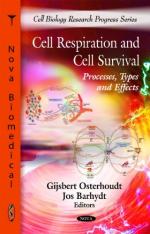|
This section contains 854 words (approx. 3 pages at 300 words per page) |

|
Cellular respiration is the process by which cells obtain energy from food through chemical reaction with an inorganic electron acceptor, usually oxygen. The principal product is adenosine triphosphate (ATP), a high energy compound used for a wide variety of energy-requiring processes in the cell. Cellular respiration occurs in three main stages: glycolysis, Krebs cycle, and oxidative phosphorylation. (In some textbooks, cellular respiration refers only to the Krebs cycle and oxidative phosphorylation, while in others, it refers only to oxidative phosphorylation). Cellular respiration is contrasted with physiologic respiration, which refers to the mechanisms of gas exchange at the lungs.
Sugars and fatty acids are the primary food sources for cells. Each contains large numbers of C-C and C-H bonds, which are relatively weak compared to C-O and H-O bonds. During cellular respiration, these weaker bonds are broken, while the stronger bonds with oxygen are formed, thus releasing...
|
This section contains 854 words (approx. 3 pages at 300 words per page) |

|


